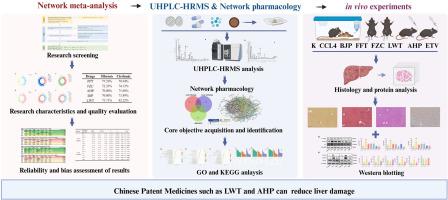中成药治疗肝纤维化、肝硬化的疗效及作用机制比较
IF 8.3
1区 医学
Q1 CHEMISTRY, MEDICINAL
引用次数: 0
摘要
肝纤维化是肝脏疾病进展的关键阶段,如果没有适当的治疗,可以发展为肝硬化。乙型肝炎病毒感染是肝纤维化的主要原因。抗病毒药物,如恩替卡韦,广泛用于治疗肝纤维化和肝硬化。此外,中成药别家健丸(BJP)、六味五灵片(LWT)、复方别家软肝片(FFT)、扶正化瘀胶囊(FZC)、安络花仙丸(AHP)等均有疗效。然而,关于最有效的治疗方法及其如何起作用,目前仍缺乏基于证据的共识。目的采用网络荟萃分析和网络药理学相结合的方法,寻找治疗肝纤维化和肝硬化最有效的中成药。它还根据已发表的临床研究数据总结和评估有效治疗方法的潜在机制。目的是为临床决策提供科学依据。最后,通过实验验证了这些结果。目的是为临床决策提供科学依据。方法综合检索PubMed、Web of Science、Medica摘录数据库(EMBASE)、Cochrane图书馆、中国知网(CNKI)、唯普数据库(VIP)、万方数据库(Wanfang)等8个数据库,检索截至2025年4月发表的研究。应用纳入和排除标准,分析临床结果,如透明质酸(HA)、层粘连蛋白(LN)、IV型胶原蛋白(IV- c)、III型前胶原蛋白(PC-III)、天冬氨酸转氨酶(AST)、丙氨酸转氨酶(ALT)、总胆红素(TBIL)。利用网络药理学方法构建蛋白-蛋白相互作用(PPI)网络,通过CytoScape 3.10.0中的CytoHubba鉴定核心基因。使用基因本体(GO)和京都基因与基因组百科全书(KEGG)途径分析来探索潜在的机制。接下来,我们通过体内实验验证了这些预测,通过HE染色、Masson三色染色、Picro天狼星红染色和免疫组织化学观察病理变化,并使用Western blotting进行蛋白质表达分析。结果共纳入380项研究,涉及37,380例患者。采用累积排序曲线下曲面(SUCRA)和秩1概率对各处方的疗效进行评价。对于肝纤维化,AHP最有效,其次是LWT、FZC、BJP和FFT。在肝硬化治疗中,LWT最有效,其次是AHP、FZC、BJP和FFT。结合网络药理学分析发现AHP和LWT可能通过调控信号转导和转录激活因子3 (STAT3)、基质金属肽酶9 (MMP9)、蛋白激酶B (AKT1)等靶点在肝纤维化和肝硬化中发挥作用。动物实验表明,LWT、AHP等中成药能显著改善小鼠肝损伤,降低CCL4组α-平滑肌肌动蛋白(α-SMA)、转化生长因子β (TGF-β)、纤维连接蛋白(FN)、STAT3、MMP9水平,增加AKT1表达和含量。结论根据目前的网络荟萃分析,ahp和LWT分别是治疗肝纤维化和肝硬化最有效的方法。LWT和AHP可能通过调节STAT3、MMP9、AKT1等靶点在肝纤维化和肝硬化中发挥作用,为临床治疗策略提供坚实的基础。本文章由计算机程序翻译,如有差异,请以英文原文为准。

Comparison of the efficacy and action mechanism of Chinese patent medicines for liver fibrosis and cirrhosis
Background
Liver fibrosis is a critical stage in liver disease progression and can advance to cirrhosis without appropriate treatment. Hepatitis B virus infection is the primary cause of liver fibrosis. Antiviral drugs, e.g., entecavir, are widely used to treat liver fibrosis and cirrhosis. Additionally, Chinese patent medicines, such as Biejiajian Pill (BJP), Liuwei Wuling Tablet (LWT), Fufang Biejia Ruangan Tablet (FFT), Fuzheng Huayu Capsule (FZC), and Anluo Huaxian Pill (AHP), demonstrate therapeutic effects. However, there is still insufficient evidence-based agreement on the most effective therapies and how they work.
Objective
This study aims to identify the most effective Chinese patent medicines for treating liver fibrosis and cirrhosis by combining network meta-analysis and network pharmacology. It also summarises and evaluates the potential mechanisms of effective treatment methods based on published clinical research data. The aim is to provide scientific evidence for clinical decision-making. Finally, these results were verified through experiments. The aim is to provide a scientific basis for clinical decision-making.
Methods
We conducted a comprehensive search of eight databases (PubMed, Web of Science, Excerpta Medica Database (EMBASE), Cochrane Library, China National Knowledge Infrastructure (CNKI), Weipu Database (VIP), and Wanfang) for studies published up to April 2025. After applying inclusion and exclusion criteria, clinical outcomes such as Hyaluronic Acid (HA), Laminin (LN), Type IV Collagen (IV-C), Type III Procollagen (PC-III), Aspartate Aminotransferase (AST), Alanine Aminotransferase (ALT), and Total Bilirubin (TBIL) were analyzed. A protein-protein interaction (PPI) network was constructed using network pharmacology, with core genes identified via CytoHubba in CytoScape 3.10.0. Gene Ontology (GO) and Kyoto Encyclopedia of Genes and Genomes (KEGG) pathway analyses were used to explore the underlying mechanisms. Next, we validated these predictions using in vivo experiments, observing pathological changes through HE Staining, Masson’s Trichrome Staining, Picro Sirius Red Staining, and Immunohistochemistry, and performing protein expression analysis using Western blotting.
Results
A total of 380 studies involving 37,380 patients, were included. Surface Under the Cumulative Ranking Curve (SUCRA) and Rank 1 probability were used to assess the therapeutic efficacy of each prescription. For liver fibrosis, AHP was the most effective, followed by LWT, FZC, BJP, and FFT. In cirrhosis treatment, LWT was the most effective, followed by AHP, FZC, BJP, and FFT. Combined with network pharmacology analyses revealed that AHP and LWT might play a role in liver fibrosis and cirrhosis by regulating targets such as Signal Transducer and Activator of Transcription 3 (STAT3), Matrix Metallopeptidase 9 (MMP9), Protein kinase B (AKT1), etc. Animal experiments have shown that Chinese patent medicines such as LWT and AHP can significantly improve liver damage in mice and reduce the levels of Alpha-Smooth Muscle Actin (α-SMA), Transforming Growth Factor Beta (TGF-β), Fibronectin (FN), STAT3, and MMP9 in the CCL4 group, while increasing the expression and content of AKT1.
Conclusion
AHP and LWT are the most effective treatments for liver fibrosis and cirrhosis, respectively according to current network meta-analysis. LWT and AHP may play a role in liver fibrosis and cirrhosis by regulating targets such as STAT3, MMP9, and AKT1, providing a solid foundation for clinical treatment strategies.
求助全文
通过发布文献求助,成功后即可免费获取论文全文。
去求助
来源期刊

Phytomedicine
医学-药学
CiteScore
10.30
自引率
5.10%
发文量
670
审稿时长
91 days
期刊介绍:
Phytomedicine is a therapy-oriented journal that publishes innovative studies on the efficacy, safety, quality, and mechanisms of action of specified plant extracts, phytopharmaceuticals, and their isolated constituents. This includes clinical, pharmacological, pharmacokinetic, and toxicological studies of herbal medicinal products, preparations, and purified compounds with defined and consistent quality, ensuring reproducible pharmacological activity. Founded in 1994, Phytomedicine aims to focus and stimulate research in this field and establish internationally accepted scientific standards for pharmacological studies, proof of clinical efficacy, and safety of phytomedicines.
 求助内容:
求助内容: 应助结果提醒方式:
应助结果提醒方式:


